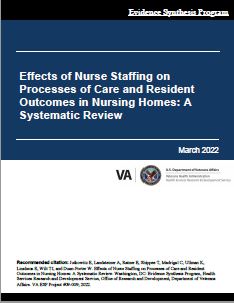
Recommended citation:
Jutkowitz E, Landsteiner A, Ratner E, Shippee T, Madrigal C, Ullman K, Linskens E, Wilt TJ, and Duan-Porter W. Effects of Nurse Staffing on Processes of Care and Resident Outcomes in Nursing Homes: A Systematic Review. Washington, DC: Evidence Synthesis Program, Health Services Research and Development Service, Office of Research and Development, Department of Veterans Affairs. VA ESP Project #09-009; 2022.
Download PDF: Complete Report, Executive Summary, Report, Appendices
Observational evidence indicate that higher registered nurse staffing and skill mix were associated with fewer resident pressure ulcers and nursing home-associated infections, and lower rates of moderate-severe pain (low confidence). These findings may not generalize to VA Community Living Centers (CLCs), which have different resident characteristics and higher staffing than non-VA community nursing homes. More accurate data and randomized study designs may be required to evaluate definitively the effects of nurse staffing on resident outcomes.
Nursing homes are complex environments serving residents with diverse needs. Registered nurses (RN), licensed practical nurses (LPN), and nursing assistants (NA) all contribute to care for nursing home residents. The level and characteristics of nurse staffing may impact resident well-being, health, safety, and quality of life. To support the VA Office of Nursing Services, we conducted an evidence review on the effect of nursing staff on resident outcomes and processes of care.
We identified 44 eligible studies addressing processes of care and resident outcomes in nursing homes. Only 1 study focused on outcomes in VA CLCs; all other studies addressed outcomes in non-VA community nursing homes. All eligible studies were observational, with the vast majority using CMS datasets. The most frequently addressed outcomes were pressure ulcers and nursing home-associated infections, with one-third of the latter group evaluating COVID-19. Higher RN staffing is probably associated with fewer pressure ulcers (moderate confidence); it may also be associated with lower COVID-19 infection and mortality, fewer urinary tract infections, and lower rates of moderate-severe pain (low confidence for these findings). For LPN and NA staffing, total nurse staffing, and skill mix, effects varied across resident outcomes. There were substantial methodological concerns regarding accuracy of staffing and outcomes data, timing of outcomes assessment (with respect to staffing data), and adequate consideration of confounders.
Effects of Nurse Staffing on Processes of Care and Nursing Home Outcomes: A Systematic Review (Management eBrief)
Jutkowitz E, Landsteiner A, Ratner E, et al. Effects of Nurse Staffing on Resident Outcomes in Nursing Homes: A Systematic Review. Journal of the American Medical Directors Association. Published online December 5, 2022. DOI: https://doi.org/10.1016/j.jamda.2022.11.002.